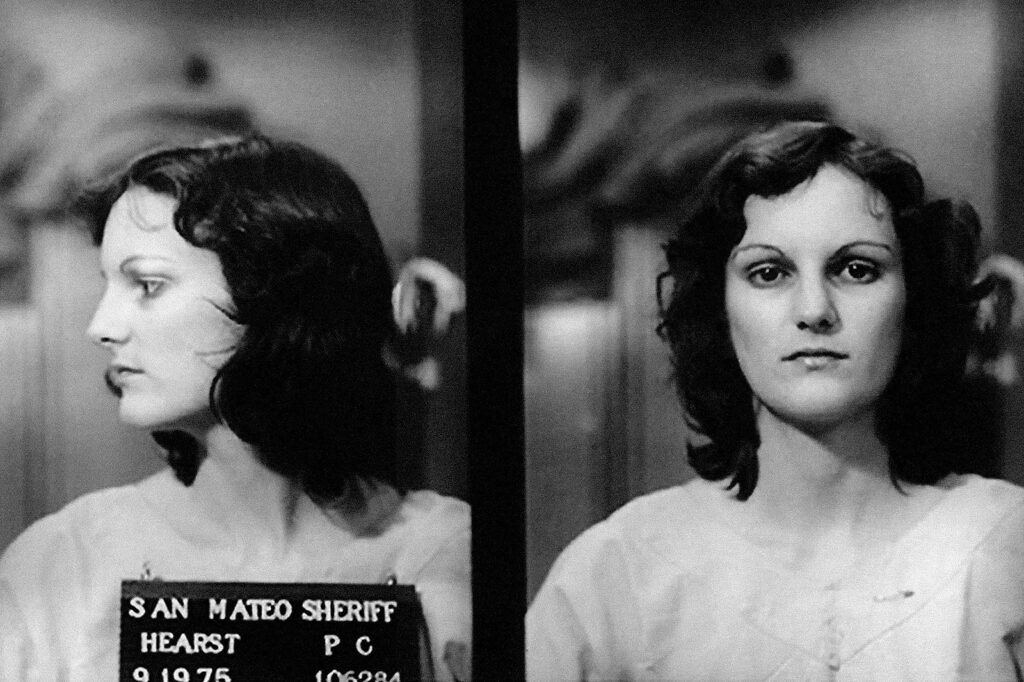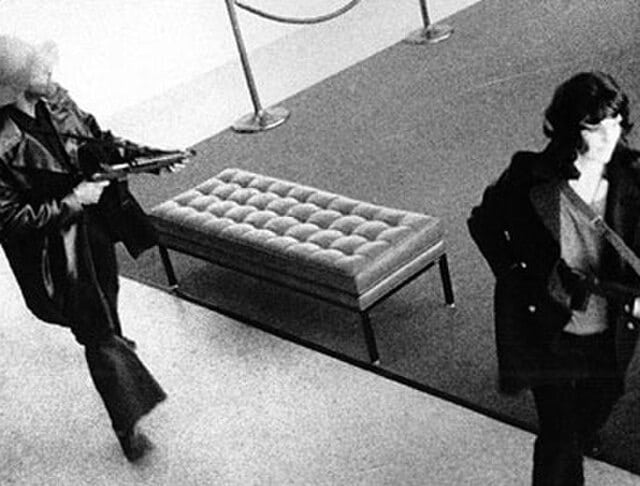When Patty Hearst was kidnapped from her apartment in Berkeley, California, she was an unwilling victim. When the group that took her, the Symbionese Liberation Army, shoved Patty blindfolded into a closet, she was still a victim.
So why, just a few months later, was she seen, rifle in hand, robbing a bank with the very people that had stolen her away so violently? Who was Patty Hearst, and how did she go from kidnapping victim to willing member of the SLA in so short a time?
Even today there is debate on whether Patty did what she did for the SLA willingly. Or was she forced, or even brainwashed into doing so?
Below, we will look closer at the kidnapping of Patty Heart, the time that she was held hostage, and what happened when she was finally separated from the SLA.

Heiress and Socialite: The Background of Patty Hearst
Patricia Hearst was born on February 20, 1945, to Randolph Apperson Hearst and Catherine Wood Campbell. The family lived in San Francisco, California at the time of her birth, and she was the third of five daughters.
The Hearst’s were wealthy, to say the least. Patty’s grandfather was newspaper tycoon William Randolph Hearst. While her father wasn’t the direct heir of the Hearst fortune, he did receive a portion of it and this wealth allowed Patty a very privileged upbringing.
She attended a slew of private schools as a child. After graduation, she enrolled at the University of California, Berkeley as an art history major.
The 1970s were rife with political unrest and all sorts of small uprisings amongst younger people of the day. But Patty was still somewhat sheltered by the time she started attending college.
In 1974, Patty’s life for the first time was somewhat tumultuous. She had defied her parents and moved in with a boyfriend at Berkeley, but the gild was off the lily by the time of her kidnapping.
The young heiress and socialite felt adrift. She didn’t want to admit to her parents that she had been wrong to move in with her lover, but she was also over living with the man already.
She was 19, in her sophomore year of college, and no one could expect what would happen to Patty Hearst next.
The Symbionese Liberation Army
The Symbionese Liberation Army, or SLA, was a short-lived radical far-left movement. It caused an absurd amount of chaos in the two years it was active.
Focused on social justice, particularly issues related to race and class, the SLA had no problem resorting to violence to get their point across. Because of this, the group is considered to be the first terrorist organization to come out of the political left.
Despite the notoriety the organization would gain for taking Patty, they weren’t a large group, never rising above 22 members. When they targeted Patty Hearst, the initial hope was that they could bargain the freedom of the heiress for the release of two of the SLA’s founding members who had been jailed, Russell Little and Joseph Remiro.
When this didn’t pan out, they decided to keep Patty. This set into motion the events that would have the public wondering if Patty Hearst was a victim, or a radical domestic terrorist herself.
The Kidnapping of Patty Hearst
The SLA didn’t have anything against Patty Hearst specifically–it was more of a wrong place, wrong time situation for the young woman.
Earlier in the year, local newspaper The San Francisco Chronicle had announced Hearst’s engagement to the boyfriend she had been living with, Steven Weed, with her full address included. Her apartment was close to the SLA headquarters. Therefore, on February 4, 1974, the group decided to strike.
They took Patty Hearst from her apartment and back to one of their safe houses. From there, things become less clear.
Early Days in Captivity
Patty Hearst’s kidnapping was huge news, but the initial search for her turned up nothing. The SLA moved her from house to house, where Patty claimed to have been bound, blindfolded, and shoved into a closet for days at a time.
She would only be released to use the restroom and eat. Later, they would allow her to attend SLA group meetings. It was here that, according to Patty and her mother, the brainwashing began.
When authorities refused to trade Hearst for the imprisoned SLA members, the group changed their demands. Instead, they wanted $70 of food provided to every Californian in need.
While not the vast undertaking the SLA wanted, Patty’s dad did try to assuage his daughter’s captors by donating 2 million dollars of food to the poor in the area.
Despite this, Patty wasn’t let go. She was given SLA propaganda to read and was integrated more and more into the group. Eventually, the SLA group leader, Donald DeFreeze, gave Patty a choice–be released, or join the SLA. Patty chose the latter.
Joining the SLA, Bank Robberies and Patty Hearst’s Arrest
The next few months were a whirlwind of activity involving Patty Hearst and the SLA. She recorded and released pro-SLA propaganda messages, renaming herself Tania and announcing her willingness to join the organization.
Most notable was the bank robbery that took place on April 15, 1974, just a few months after Patty’s kidnapping. Patty Hearst and a number of other SLA members held up the Sunset District Hibernia Bank in San Francisco and were all caught on camera.

On the recordings, Patty was enthusiastically participating in the robbery. This led investigators to believe that she was no longer a victim, but a willing, active member of the SLA, making her just as guilty as all the others.
The bank robbery was pulled off, and the next sighting of Patty Hearst would come on May 16 of the same year. Two other members of the group, William and Emily Harris were shopping at a sporting goods store, attempting to shoplift before leaving the store.
Hearst, who was waiting in the car, watched as security for the store tried to tackle William to the ground. She exited the car and fired multiple shots into the storefront, giving the Harrises time to escape.
The trio hijacked cars to get away. However, they were forced to go on the run when it came to light that police had found the main SLA base and raided it, resulting in a firefight that killed multiple SLA members.
From there things descended into chaos for Hearst. She assisted the Harris’s in making makeshift explosive devices, but none of their attempts to injure and kill police officers ever worked.
She was also linked to a separate bank robbery where it was discovered that Emily Harris had shot and killed a mother named Myrna Opshal. The charges against the heiress were building and building.
Finally, on September 18, 1974, Hearst was arrested inside a San Francisco apartment that was serving as an SLA hideout.
The Trial–Insanity, Stockholm Syndrome, or Willing Participant?
Immediately, claims were made by Hearst’s family that the young woman was suffering from Stockholm Syndrome. Some experts were dubious.
However, signs did point to Patty having undergone some sort of psychological damage as part of the SLA–she was only 87 pounds upon arrest. Also, her IQ score was found to be significantly lower than before she was kidnapped.
Patty held firm to her SLA beliefs for a short time, before reversing and agreeing that she had been brainwashed. She told the court that her life had been threatened, and that she had been forced to participate in the bank robbery.
Ultimately, Patty Hearst was found guilty of bank robbery and using a firearm during the commission of a felony. She was initially sentenced to 35 years in prison–the maximum amount of time for her crimes, but she wouldn’t serve nearly that much.
Her sentence was first changed to 7 years, and she served a total of 22 months before her sentence was commuted by President Jimmy Carter. Later, President Bill Clinton granted her a full pardon.
Life After the SLA
After being released from prison, Patty Hearst went on to live a relatively normal life. She married and had children. She used her short-lived notoriety to gain roles in television and films, including a large number of John Waters films.
Whether Patty Hearst chose to join the SLA or was coerced, the days of her kidnapping are long behind her.
References
“Whose Side Was She On? ‘American Heiress’ Revisits Patty Hearst’s Kidnapping”-Jeffery Toobin https://www.npr.org/2016/08/03/488373982/whose-side-was-she-on-american-heiress-revisits-patty-hearst-s-kidnapping
“Patty Hearst” https://www.britannica.com/biography/Patty-Hearst

